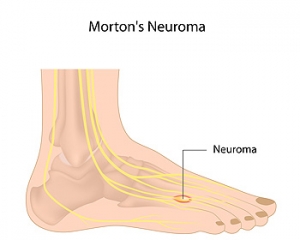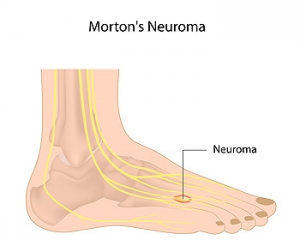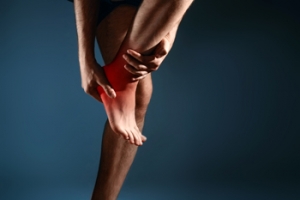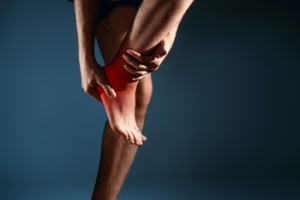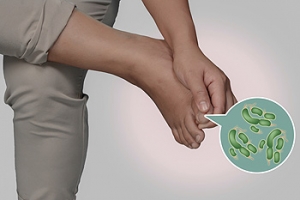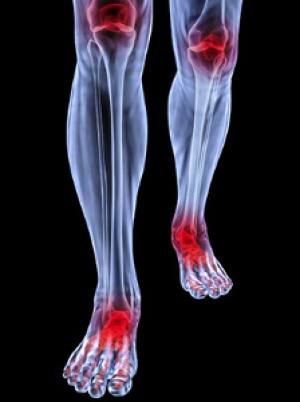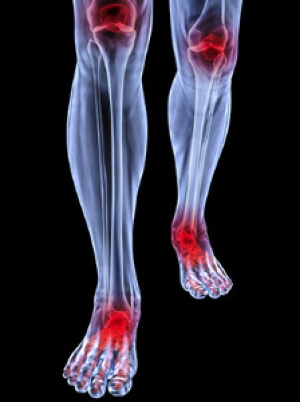Items filtered by date: October 2018
Symptoms of Morton’s Neuroma
If you experience pain and discomfort between the third and fourth toes, you may have a condition that is referred to as Morton’s neuroma. The pain originates from tissue that has been affected as a result of a swollen nerve on the bottom of the foot. Research has shown that being involved in specific sports or wearing high heels may play a significant role in the development of this uncomfortable condition. Patients often notice a burning sensation in the ball of the foot. This may intensify as weight is put on the foot, in addition to a numbness or tingling feeling. Relief may be obtained by wearing correct footwear or gently massaging the affected area. If you feel you may have Morton’s neuroma, it’s advised to seek the counsel of a podiatrist who can properly inform you of correct treatment techniques.
Morton’s neuroma is a very uncomfortable condition to live with. If you think you have Morton’s neuroma, contact Dr. Kenneth Donovan of Advanced Care Foot and Ankle. Our doctor will attend to all of your foot care needs and answer any of your related questions.
Morton’s Neuroma
Morton's neuroma is a painful foot condition that commonly affects the areas between the second and third or third and fourth toe, although other areas of the foot are also susceptible. Morton’s neuroma is caused by an inflamed nerve in the foot that is being squeezed and aggravated by surrounding bones.
What Increases the Chances of Having Morton’s Neuroma?
- Ill-fitting high heels or shoes that add pressure to the toe or foot
- Jogging, running or any sport that involves constant impact to the foot
- Flat feet, bunions, and any other foot deformities
Morton’s neuroma is a very treatable condition. Orthotics and shoe inserts can often be used to alleviate the pain on the forefront of the feet. In more severe cases, corticosteroids can also be prescribed. In order to figure out the best treatment for your neuroma, it’s recommended to seek the care of a podiatrist who can diagnose your condition and provide different treatment options.
If you have any questions, please feel free to contact one of our offices located in Warren, Livingston, and Toms River, NJ . We offer the newest diagnostic and treatment technologies for all your foot care needs.
Symptoms of Morton’s Neuroma
 If you experience pain and discomfort between the third and fourth toes, you may have a condition that is referred to as Morton’s neuroma. The pain originates from tissue that has been affected as a result of a swollen nerve on the bottom of the foot. Research has shown that being involved in specific sports or wearing high heels may play a significant role in the development of this uncomfortable condition. Patients often notice a burning sensation in the ball of the foot. This may intensify as weight is put on the foot, in addition to a numbness or tingling feeling. Relief may be obtained by wearing correct footwear or gently massaging the affected area. If you feel you may have Morton’s neuroma, it’s advised to seek the counsel of a podiatrist who can properly inform you of correct treatment techniques.
If you experience pain and discomfort between the third and fourth toes, you may have a condition that is referred to as Morton’s neuroma. The pain originates from tissue that has been affected as a result of a swollen nerve on the bottom of the foot. Research has shown that being involved in specific sports or wearing high heels may play a significant role in the development of this uncomfortable condition. Patients often notice a burning sensation in the ball of the foot. This may intensify as weight is put on the foot, in addition to a numbness or tingling feeling. Relief may be obtained by wearing correct footwear or gently massaging the affected area. If you feel you may have Morton’s neuroma, it’s advised to seek the counsel of a podiatrist who can properly inform you of correct treatment techniques.
Morton’s neuroma is a very uncomfortable condition to live with. If you think you have Morton’s neuroma, contact Dr. Kenneth Donovan of Advanced Care Foot and Ankle. Our doctor will attend to all of your foot care needs and answer any of your related questions.
Morton’s Neuroma
Morton's neuroma is a painful foot condition that commonly affects the areas between the second and third or third and fourth toe, although other areas of the foot are also susceptible. Morton’s neuroma is caused by an inflamed nerve in the foot that is being squeezed and aggravated by surrounding bones.
What Increases the Chances of Having Morton’s Neuroma?
- Ill-fitting high heels or shoes that add pressure to the toe or foot
- Jogging, running or any sport that involves constant impact to the foot
- Flat feet, bunions, and any other foot deformities
Morton’s neuroma is a very treatable condition. Orthotics and shoe inserts can often be used to alleviate the pain on the forefront of the feet. In more severe cases, corticosteroids can also be prescribed. In order to figure out the best treatment for your neuroma, it’s recommended to seek the care of a podiatrist who can diagnose your condition and provide different treatment options.
If you have any questions, please feel free to contact one of our offices located in Warren, Livingston, and Toms River, NJ . We offer the newest diagnostic and treatment technologies for all your foot care needs.
Different Types of Foot Surgery
There are several reasons why it may be necessary to have foot surgery performed. These may include having a foot deformity corrected, relieving severe pain and discomfort, or to have normal function returned to your foot or ankle. A common surgery that involves having the toenail removed may be a suitable cure for specific foot conditions such as ingrown toenails. Additionally, for people who suffer from the constant pain of an ankle disorder, a procedure that is known as open ankle fusion surgery may be a viable option to obtain moderate or full relief. Bunion surgery may be necessary for the permanent removal of painful bunions if all other options should fail. If you are contemplating foot surgery, it’s advised to speak with a podiatrist who can properly inform you of any information you need to know, so a proper decision can be reached.
Foot surgery is sometimes necessary to treat a foot ailment. To learn more, contact Dr. Kenneth Donovan of Advanced Care Foot and Ankle. Our doctor will assist you with all of your foot and ankle needs.
When Is Surgery Necessary?
Foot and ankle surgery is generally reserved for cases in which less invasive, conservative procedures have failed to alleviate the problem. Some of the cases in which surgery may be necessary include:
- Removing foot deformities like bunions and bone spurs
- Severe arthritis that has caused bone issues
- Cosmetic reconstruction
What Types of Surgery Are There?
The type of surgery you receive will depend on the nature of the problem you have. Some of the possible surgeries include:
- Bunionectomy for painful bunions
- Surgical fusion for realignment of bones
- Neuropathy decompression surgery to treat nerve damage
Benefits of Surgery
Although surgery is usually a last resort, it can provide more complete pain relief compared to non-surgical methods and may allow you to finally resume full activity.
Surgical techniques have also become increasingly sophisticated. Techniques like endoscopic surgery allow for smaller incisions and faster recovery times.
If you have any questions please feel free to contact one of our offices located in Warren, Livingston, and Toms River, NJ. We offer the newest diagnostic and treatment technologies for all your foot and ankle needs.
Why do Stress Fractures Develop?
If you enjoy the sport of running or jogging, you may develop a stress fracture. This may gradually occur from the frequent repetitive motion that accompanies this type of activity. Despite the fact that many people who engage in sports may endure the discomfort of a stress fracture, certain individuals may be prone to developing this ailment. This may include having a medical condition that may weaken the bones, or experiencing a disorder that may affect the nerves. This may result in a loss of feeling. The pain that is associated with this condition may not be felt. The noticeable symptoms may include pain and discomfort and may be more intense in one foot. After an MRI or bone scan is performed, the proper treatment options can be discussed, such as possibly wearing a cast or boot or taking certain medications. Please consult with a podiatrist if you have endured a stress fracture and would like information about correct treatment techniques that are right for you.
Stress fractures occur when there is a tiny crack within a bone. To learn more, contact Dr. Kenneth Donovan from Advanced Care Foot and Ankle. Our doctor can provide the care you need to keep you pain free and on your feet.
How Are They Caused?
Stress fractures are the result of repetitive force being placed on the bone. Since the lower leg and feet often carry most of the body’s weight, stress fractures are likely to occur in these areas. If you rush into a new exercise, you are more likely to develop a stress fracture since you are starting too much, too soon.
Pain resulting from stress fractures may go unnoticed at first, however it may start to worsen over time.
Risk Factors
- Gender – They are more commonly found in women compared to men.
- Foot Problems – People with unusual arches in their feet are more likely to develop stress fractures.
- Certain Sports – Dancers, gymnasts, tennis players, runners, and basketball players are more likely to develop stress fractures.
- Lack of Nutrients – A lack of vitamin D and calcium may weaken the bones and make you more prone to stress fractures
- Weak Bones – Osteoporosis can weaken the bones therefore resulting in stress fractures
Stress fractures do not always heal properly, so it is important that you seek help from a podiatrist if you suspect you may have one. Ignoring your stress fracture may cause it to worsen, and you may develop chronic pain as well as additional fractures.
If you have any questions, please feel free to contact one of our offices located in Warren, Livingston, and Toms River, NJ. We offer the newest diagnostic and treatment technologies for all your foot care needs.
Why do Stress Fractures Develop?
 If you enjoy the sport of running or jogging, you may develop a stress fracture. This may gradually occur from the frequent repetitive motion that accompanies this type of activity. Despite the fact that many people who engage in sports may endure the discomfort of a stress fracture, certain individuals may be prone to developing this ailment. This may include having a medical condition that may weaken the bones, or experiencing a disorder that may affect the nerves. This may result in a loss of feeling. The pain that is associated with this condition may not be felt. The noticeable symptoms may include pain and discomfort and may be more intense in one foot. After an MRI or bone scan is performed, the proper treatment options can be discussed, such as possibly wearing a cast or boot or taking certain medications. Please consult with a podiatrist if you have endured a stress fracture and would like information about correct treatment techniques that are right for you.
If you enjoy the sport of running or jogging, you may develop a stress fracture. This may gradually occur from the frequent repetitive motion that accompanies this type of activity. Despite the fact that many people who engage in sports may endure the discomfort of a stress fracture, certain individuals may be prone to developing this ailment. This may include having a medical condition that may weaken the bones, or experiencing a disorder that may affect the nerves. This may result in a loss of feeling. The pain that is associated with this condition may not be felt. The noticeable symptoms may include pain and discomfort and may be more intense in one foot. After an MRI or bone scan is performed, the proper treatment options can be discussed, such as possibly wearing a cast or boot or taking certain medications. Please consult with a podiatrist if you have endured a stress fracture and would like information about correct treatment techniques that are right for you.
Stress fractures occur when there is a tiny crack within a bone. To learn more, contact Dr. Kenneth Donovan from Advanced Care Foot and Ankle. Our doctor can provide the care you need to keep you pain free and on your feet.
How Are They Caused?
Stress fractures are the result of repetitive force being placed on the bone. Since the lower leg and feet often carry most of the body’s weight, stress fractures are likely to occur in these areas. If you rush into a new exercise, you are more likely to develop a stress fracture since you are starting too much, too soon. Pain resulting from stress fractures may go unnoticed at first, however it may start to worsen over time.
Risk Factors
- Gender – They are more commonly found in women compared to men.
- Foot Problems – People with unusual arches in their feet are more likely to develop stress fractures.
- Certain Sports – Dancers, gymnasts, tennis players, runners, and basketball players are more likely to develop stress fractures.
- Lack of Nutrients – A lack of vitamin D and calcium may weaken the bones and make you more prone to stress fractures
- Weak Bones – Osteoporosis can weaken the bones therefore resulting in stress fractures
Stress fractures do not always heal properly, so it is important that you seek help from a podiatrist if you suspect you may have one. Ignoring your stress fracture may cause it to worsen, and you may develop chronic pain as well as additional fractures.
If you have any questions, please feel free to contact one of our offices located in Warren, Livingston, and Toms River, NJ . We offer the newest diagnostic and treatment technologies for all your foot care needs.
Signs You May Have Athlete’s Foot
If you have noticed that your feet are scaling and itchy, you may have a condition that is referred to as athlete’s feet. The most common place of discomfort may occur in between the toes, and this may lead to the formation of blisters. This contagious fungal infection typically thrives in moist places including public pools and shower floors. There are several symptoms that are associated with this uncomfortable condition including peeling skin, a burning sensation on the soles of the feet or in between the toes, in addition to severe itching. To prevent the onset of athlete's foot, it is suggested that appropriate shoes are worn in locker rooms, public pools, showers, and surrounding areas. Additionally, choosing to wear shoes that consist of breathable materials may aid in controlling this condition. Cotton socks may absorb any excess sweat that exists, and this may help to maintain a level of comfort. Please consult with a podiatrist if you are afflicted with athlete’s foot to learn about correct treatment techniques that are right for you.
Athlete’s Foot
Athlete’s foot is often an uncomfortable condition to experience. Thankfully, podiatrists specialize in treating athlete’s foot and offer the best treatment options. If you have any questions about athlete’s foot, consult with Dr. Kenneth Donovan from Advanced Care Foot and Ankle. Our doctor will assess your condition and provide you with quality treatment.
What Is Athlete’s Foot?
Tinea pedis, more commonly known as athlete’s foot, is a non-serious and common fungal infection of the foot. Athlete’s foot is contagious and can be contracted by touching someone who has it or infected surfaces. The most common places contaminated by it are public showers, locker rooms, and swimming pools. Once contracted, it grows on feet that are left inside moist, dark, and warm shoes and socks.
Prevention
The most effective ways to prevent athlete’s foot include:
- Thoroughly washing and drying feet
- Avoid going barefoot in locker rooms and public showers
- Using shower shoes in public showers
- Wearing socks that allow the feet to breathe
- Changing socks and shoes frequently if you sweat a lot
Symptoms
Athlete’s foot initially occurs as a rash between the toes. However, if left undiagnosed, it can spread to the sides and bottom of the feet, toenails, and if touched by hand, the hands themselves. Symptoms include:
- Redness
- Burning
- Itching
- Scaly and peeling skin
Diagnosis and Treatment
Diagnosis is quick and easy. Skin samples will be taken and either viewed under a microscope or sent to a lab for testing. Sometimes, a podiatrist can diagnose it based on simply looking at it. Once confirmed, treatment options include oral and topical antifungal medications.
If you have any questions, please feel free to contact one of our offices located in Warren, Livingston, and Toms River, NJ . We offer the newest diagnostic and treatment technologies for all your foot care needs.
Foot Conditions That May Occur as a Result of Rheumatoid Arthritis
If you are afflicted with rheumatoid arthritis, you may develop foot conditions that may be associated with this ailment. There are several symptoms that may be connected with this condition, including discomfort and soreness in the feet, instability involving the joints of the toes, the front of the foot, and swelling. Fluid filled sacs, which is referred to as bursae, may develop as a result of the inflammation that occurs. This is due to extreme rubbing, especially on the sole of the foot. Corns, calluses and blisters may be side effects of this painful condition, in addition to circulatory problems concerning the feet. If you feel you are in the process of developing rheumatoid arthritis, it’s strongly suggested to speak with a podiatrist who can offer proper treatment options for this ailment.
Because RA affects more than just your joints, including the joints in your feet and ankles, it is important to seek early diagnosis from your podiatrist if you feel like the pain in your feet might be caused by RA. For more information, contact Dr. Kenneth Donovan of Advanced Care Foot and Ankle. Our doctor will assist you with all of your podiatric concerns.
What Is Rheumatoid Arthritis?
Rheumatoid Arthritis (RA) is an autoimmune disorder in which the body’s own immune system attacks the membranes surrounding the joints. Inflammation of the lining and eventually the destruction of the joint’s cartilage and bone occur, causing severe pain and immobility.
Rheumatoid Arthritis of the Feet
Although RA usually attacks multiple bones and joints throughout the entire body, almost 90 percent of cases result in pain in the foot or ankle area.
Symptoms
- Swelling and pain in the feet
- Stiffness in the feet
- Pain on the ball or sole of feet
- Joint shift and deformation
Diagnosis
Quick diagnosis of RA in the feet is important so that the podiatrist can treat the area effectively. Your doctor will ask you about your medical history, occupation, and lifestyle to determine the origin of the condition. Rheumatoid Factor tests help to determine if someone is affected by the disease.
If you have any questions please feel free to contact one of our offices located in Warren, Livingston, and Toms River, NJ . We offer the newest diagnostic and treatment technologies for all your foot and ankle needs.
Foot Conditions That May Occur as a Result of Rheumatoid Arthritis
 If you are afflicted with rheumatoid arthritis, you may develop foot conditions that may be associated with this ailment. There are several symptoms that may be connected with this condition, including discomfort and soreness in the feet, instability involving the joints of the toes, the front of the foot, and swelling. Fluid filled sacs, which is referred to as bursae, may develop as a result of the inflammation that occurs. This is due to extreme rubbing, especially on the sole of the foot. Corns, calluses and blisters may be side effects of this painful condition, in addition to circulatory problems concerning the feet. If you feel you are in the process of developing rheumatoid arthritis, it’s strongly suggested to speak with a podiatrist who can offer proper treatment options for this ailment.
If you are afflicted with rheumatoid arthritis, you may develop foot conditions that may be associated with this ailment. There are several symptoms that may be connected with this condition, including discomfort and soreness in the feet, instability involving the joints of the toes, the front of the foot, and swelling. Fluid filled sacs, which is referred to as bursae, may develop as a result of the inflammation that occurs. This is due to extreme rubbing, especially on the sole of the foot. Corns, calluses and blisters may be side effects of this painful condition, in addition to circulatory problems concerning the feet. If you feel you are in the process of developing rheumatoid arthritis, it’s strongly suggested to speak with a podiatrist who can offer proper treatment options for this ailment.
Because RA affects more than just your joints, including the joints in your feet and ankles, it is important to seek early diagnosis from your podiatrist if you feel like the pain in your feet might be caused by RA. For more information, contact Dr. Kenneth Donovan of Advanced Care Foot and Ankle. Our doctor will assist you with all of your podiatric concerns.
What Is Rheumatoid Arthritis?
Rheumatoid Arthritis (RA) is an autoimmune disorder in which the body’s own immune system attacks the membranes surrounding the joints. Inflammation of the lining and eventually the destruction of the joint’s cartilage and bone occur, causing severe pain and immobility.
Rheumatoid Arthritis of the Feet
Although RA usually attacks multiple bones and joints throughout the entire body, almost 90 percent of cases result in pain in the foot or ankle area.
Symptoms
- Swelling and pain in the feet
- Stiffness in the feet
- Pain on the ball or sole of feet
- Joint shift and deformation
Diagnosis
Quick diagnosis of RA in the feet is important so that the podiatrist can treat the area effectively. Your doctor will ask you about your medical history, occupation, and lifestyle to determine the origin of the condition. Rheumatoid Factor tests help to determine if someone is affected by the disease.
If you have any questions please feel free to contact one of our offices located in Warren, Livingston, and Toms River, NJ . We offer the newest diagnostic and treatment technologies for all your foot and ankle needs.
